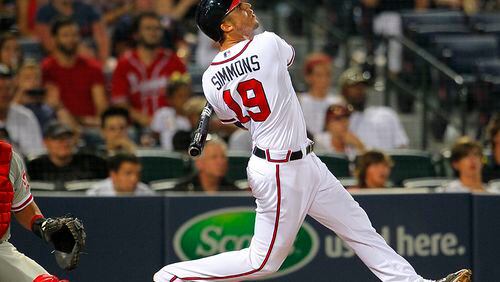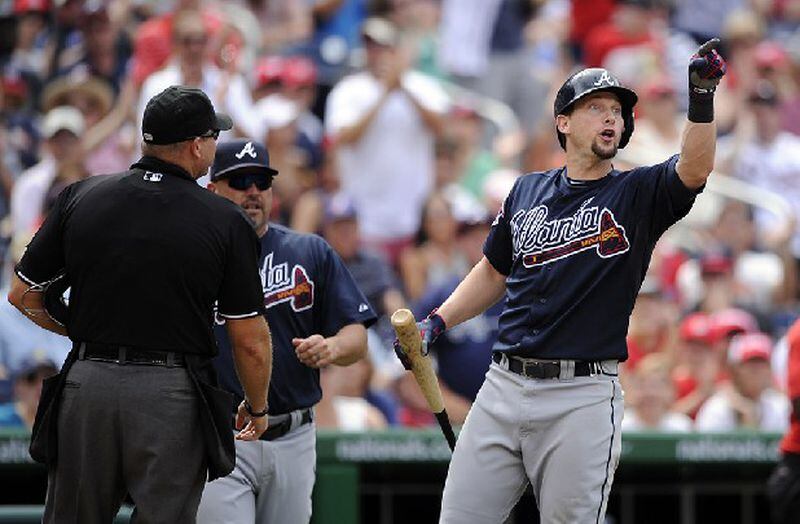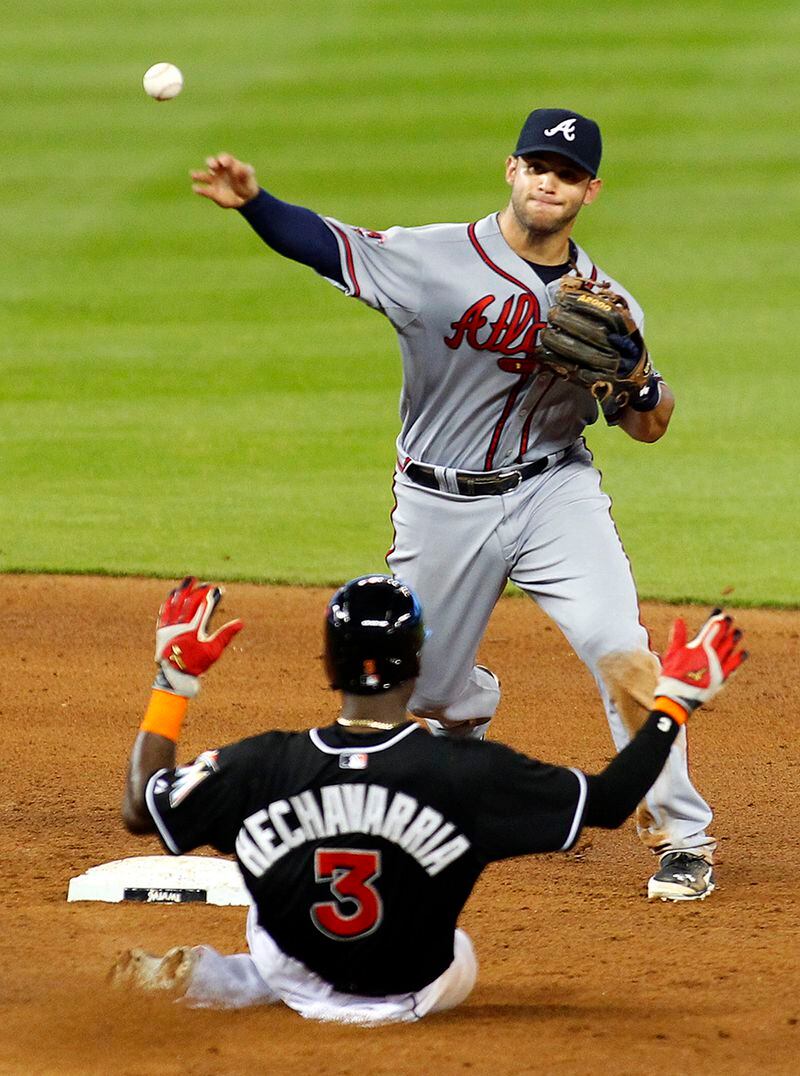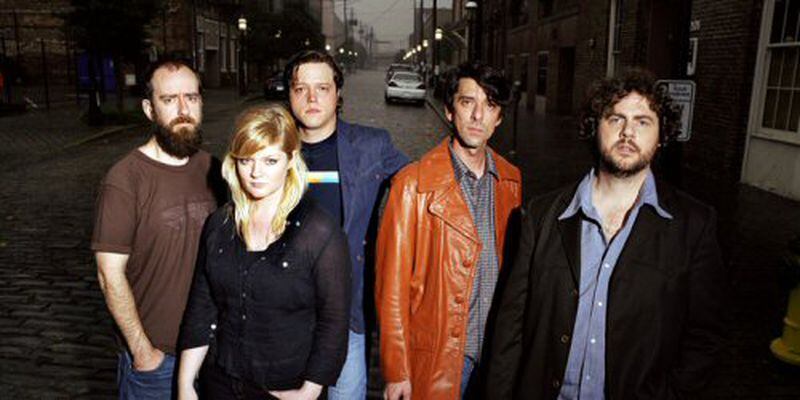Any examination of the Braves' offensive collapse in 2014 should probably start with the infield. (Not with B.J. Upton, because he was even worse in 2013 than he was in '14.)
Freddie Freeman’s RBI total slipped from a career-best 109 in 2013 to 78 in ‘14. Chris Johnson’s batting average and OPS plummeted from a career-best .321 and .816 in ’13 to .263/.653 in ’14. Andrelton Simmons’ extra-base hits and home runs fell from 50 and 17 in 2013 to 29 and 7 in ’14. And Dan Uggla was so bad that he was released in July and rookies or utility players started 129 games at second base, including 85 starts by a player with no previous big-league experience.
Freeman, Johnson, Simmons all got long-term contract extensions last year, with Freeman (eight years, $135 million) and Simmons (seven years, $58 million) signing in February and Johnson getting an oddly timed three-year, $23.5 million extension in early May after struggling in April. His extension begins this season but wouldn’t necessarily preclude the Braves from exploring or listening to trade offers if they were to severely shake up their roster this winter.
Which leads to a couple of questions: Was 2014 an anomaly in terms of offensive production from this Braves infield? And how might the unit look next season and going forward?
Start with two certainties: Freeman and the defensive wunderkind Simmons are Braves fixtures that aren’t going anywhere for the forseeable future. They are pieces the team has and will build around, despite Simmons’ offensive woes.
Freeman rebounded from a slow start to produce overall solid offensive numbers -- .288 average, .386 OBP, .847 OPS -- while playing all 162 games, but he endured the first extended hitting slump of his career and ended up with some stats -- 18 homers, 78 RBIs, .461 slugging percentage – that aren’t quite what the Braves are hoping for from the guy they gave a franchise-record $135 million contract.
Perhaps it was a sign of fatigue from playing every day, or trying to do too much with the team struggling, but for whatever reason Freeman hit .278 with just five homers, 26 RBIs and a .411 slugging percentage in 60 games after the All-Star break (he did draw 47 walks for a .388 OBP, in part because teams still preferred to face others in a weak lineup).
Compare that production to 2013, when Freeman hit .335 with 14 homers, 48 RBIs and a .544 slugging percentage in 66 games after the All-Star break, with 29 walks and a .408 OBP.
Over his first three seasons through 2013, he hit better after the break (.292 with .372 OBP and .478 slugging) than before the break (.282/.352/.460). Dramatic difference in ’14.
Freeman only had one month where he hit below .300 in 2013, and that was .291 with a .392 OBP in June. In 2014, he hit below .280 in four out of six full months.
Freeman’s average with RISP and two outs fell from an otherworldly .411 (23-for-56) in 2013 to a still-strong .310 (13-for-42) in ’14, and he drew 16 walks in those situations for a .508 OBP. Again, teams usually preferred to make other Braves beat them.
At second base, the Braves have top prospect Jose Peraza on the horizon and coming fast, after batting .339 with a .364 OBP, 11 triples and 60 stolen bases in 110 games between stops at high-A Lynchburg and Double-A Mississippi in 2014. The converted shortstop – switched last year because Simmons is entrenched at shortstop – is one of the few top position-player prospects the Braves have in their minor league system, and he’s worth getting excited about as a potential long-term leadoff man. But he’s still just 20 and has only 195 plate appearances above Single-A, so the Braves will probably give him another full year of minor-league seasoning – unless there’s a need at second base during the coming season.
Rookie second baseman Tommy La Stella was a pleasant surprise and one of the Braves’ midseason bright spots after being called from Triple-A at the end of May to replace a skidding Uggla. But after batting .297 with a .371 OBP and 21 RBIs his first 46 major league games through July 20, La Stella hit .201 with a .281 OBP and 10 RBIs in 47 games the rest of the season, and in late August manager Fredi Gonzalez began using the left-handed hitter in a second-base platoon with versatile rookie Phil Gosselin.
The La Stella-Gosselin platoon frankly didn’t make a lot of sense, given that La Stella hit better against lefties (.311/.391/.426 in 61 at-bats) than against righties (.236/.313/.291 in 258 ABs) in his first major league seaseon. La Stella also hit better against lefties than Gosselin, who was 14-for-51 (.275) a .339 OBP and .314 slugging against left-handers.
La Stella began to slump and saw his average fall from .309 in July to .193 in August, and by late August he was platooning with Gosselin. La Stella had only 32 at-bats in September, after getting 98 in June, 94 in July and 83 in August. Pitchers made adjustments to him, but before he really had much of a chance to make adjustments to them, he was a part-time player.
La Stella still finished with a .300 average in 70 at-bats with runners in scoring position, second on the team to Jason Heyward’s .301 and one of only four Braves who hit higher than .250 in as many as 35 plate appearances in those situations. La Stella was 12-for-36 (.333) with RISP and two outs, and the only other Brave to hit higher than .245 in at least 30 such at-bats was Freeman, who was 13-for-42 (.310).
Also, no Brave was as productive with bases loaded as La Stella, who led the team with six hits and 15 RBIs in those situations, going 6-for-11 (.545) with three doubles and a triple.
Gosselin was an International League All-Star at Triple-A Gwinnett in 2014, batting .344 with 39 extra-base hits (five homers) in 96 games and playing five positions. He was called up after Uggla’s release. Gosselin only got 10 at-bats in July. But he hit .344 (16-for-44) in August with a home run and .455 slugging percentage in 19 games, and Gonzalez looked for ways to get him in the lineup more after initially plugging him in occasionally at third base and second base.
Gonzalez started using Gosselin against lefties during a period when the Braves saw lefties more frequently than they had for most of the season. Gosselin hit .378 (14-for-37) in his last 13 games in August, then just .216 (16-for-74) in September with three walks, 16 strikeouts and a .266 OBP.
Gosselin doesn’t have big power and doesn’t walk much. He hit .266 (34-for-128) and .304 OBP overall with the Braves, including 2-for-18 with eight strikeouts with runners in scoring position. More than half of his at-bats coming as a second baseman, and he hit .221 (15-for-68) with a .254 OBP and .265 slugging percentage at the position.
With the exception of La Stella’s first couple of months, second base was a black hole offensively for the Braves. Besides La Stella and Gosselin, the other four Braves who played any second base in 2014 all hit .188 or lower at the position.
As a group, Braves second basemen had the majors’ third-lowest batting average (.224) , second-lowest slugging percentage (.296) and fewest runs scored (49).
At shortstop, Simmons figures to be a perennial Gold Glove winner over the length of his big contract, but it remains to be seen whether he’ll ever be a good hitter. Hitting coach Greg Walker praised his abilities, but also made it clear to Simmons that he needed to decide what kind of hitter he wanted to be and that swinging from his heels, out of control, was not a sound approach.
After hitting a rather shocking 17 homers in his first full season in 2013, Simmons had three more homers and a .483 slugging percentage in April -- and that might’ve been worst thing that could’ve happened. Because Simmons kept swinging for the fences. His max-effort, fall-across-the-plate hacks produced only four homers over the final five months of the season, and he grounded into 23 double plays in that span.
In 24 games through the end of April, he had a .289 average with three strikeouts and three homers in 90 at-bats, and only one error. In 122 games after April he batted .236 with four homers in 450 at-bats, and made 13 errors, many of which came on routine plays when it appeared the game’s best defensive shortstop seemed to lose his concentration.
He’ll surely win his second consecutive Gold Glove, because Simmons still made most routine plays to go with a bunch of spectacular plays that most other shortstops could only dream of making. But there’s no question Simmons regressed offensively, batting just .244 with a .286 OBP and .331 slugging percentage, down from .248/.296/.396 in 2013.
He had seven homers in 2014, more in line with what was expected from a guy who had a total of six homers in more than 1,000 plate appearances in his minor league career.
Here’s a sobering fact: After batting .255 with 29 extra-base hits (nine homers) in 67 games following the 2013 All-Star break, Simmons had 29 extra-base hits (seven homers) in the entire 2014 season. He had 29 RBIs and a .472 slugging percentage after the All-Star break in 2013, and 16 RBIs and a .279 slugging percentage in 56 games after the break in 2014.
At third base, Johnson went from a career-best 2013 season in which he ranked second in the National League with a .321 batting average, to a 2014 season in which he batted .263 and ranked among the league leaders in strikeouts and double plays grounded into. A season that was so underwhelming, reporters and fans alike wondered what the Braves were thinking with the timing of the $23.5 contract extension he got May 2, when he was batting .255 with one homer and four RBIs in 26 games.
The contract kicks in next season and includes salaries of $6 million in 2015, $7.5 million 2016 and $9 million in 2017, with a $10 million team option for 2018 that has a $1 million buyout. He would’ve otherwise been eligible for free agency after the 2016 season. Some familiar with the Braves’ thinking at the time they gave him the extension said the deal was at or below market value and would make Johnson tradeable if the team wanted to move him at any point.
If they wanted to improve at third base this winter, the Braves would likely have to do it via trade, as free-agent options are top-heavy and the best of the group – Hanley Ramirez, Pablo Sandoval, Chase Headley – are expected to stay put and/or get contracts significantly larger than the Braves would want to pay. The Braves could trade for a third baseman, but seem more inclined to stick with Johnson to start the 2015 season and see if he’ll recapture something similar to his 2013 form.
There aren’t any majors-ready third-base options in the Braves system except Gosselin. However, prospect Kyle Kubitza, 24, a third-round draft pick in 2011, could be ready in another year if he continues the progress he made at Double-A Mississippi, where he hit .295 with a .405 OBP, 50 extra-base hits (11 triples, eight homers) and 21 steals in 132 games.
In 2014 Johnson was again terrific against left-handed pitchers, batting a league-best .395 (45-for-114) with 12 extra-base hits and a .553 slugging percentage after batting .383 against lefties in 2013. However, the third baseman’s production against right-handers took a tumble, and that was particularly problematic given that he and the Braves faced about four times as many right-handers as lefties.
Johnson hit just .231 with a .314 slugging percentage and 134 strikeouts in 434 at-bats against right-handers in 2014, after batting .299 with a .433 slugging percentage and 86 strikeouts in 381 at-bats against righties in 2013. And after ranking among NL leaders with a .390 average and 32 RBIs in 59 at-bats with runners in scoring position and two outs in 2013, he hit just .205 with 18 RBIs in 73 at-bats in those situations in 2014.
Much like Simmons, who homered in consecutive games April 13-14, one of the worst things that happened to Chris Johnson offensively in 2014 was his three-homer barrage at Wrigley Field in the last two games before the All-Star break. The third baseman says he got away from his swing after that and got caught up in trying to hit more homers.
After getting off to a brutal start– he hit .236 with a .267 OBP and four RBIs in 30 games through May 5 – Johnson got back on track and hit .310 with 23 RBIs in his next 53 games through July 2. Then he went 3-for-28 with 12 strikeouts in his next seven games before going 5-for-9 with three homers and seven RBIs on a windy weekend at Wrigley Field, where Johnson has a .356 average and seven homers in 24 career games.
He hit two more homers in his first seven games after the All-Star break and had a .288 average and 13 RBIs in his first 17 games after the break. But from that point, after August 5 Johnson hit just .220 with two homers and nine RBIs in his last 44 games, striking out 48 times in 159 at-bats in that period and grounding into seven more double plays to raise his season total to 23, fewer than only three major leaguers: Casey McGehee (31), Albert Pujols (28) and Simmons (25).
Freeman also grounded into 18 double plays, making it three Braves infielders among the NL’s top 12 in that category.
Johnson also ranked eighth in the league in strikeouts with 159, although that was only the third-most on the team behind the Uptons, B.J. (173) and Justin (171). Freeman had 145 strikeouts, giving the Braves four of the NL’s top 11 in whiffs.
The Braves’ struggles also included their bench. Veteran Ramiro Pena entered the season as their top backup infielder, but never got back to the form he showed before a season-ending shoulder injury in late June 2013 that required surgery.
Pena hit .278 with eight extra-base hits and a .330 OBP in 97 at-bats in 2013, including .313 (25-for-80) against right-handers. In 2014, he hit just .245 with nine extra-base hits in 147 at-bats, including .235 (28-for-119) with 29 strikeouts against righties.
• Let's close with some DBT. It's almost impossible to pick my favorite Drive-By Truckers song, but if I had to choose one this might be it. Perfection. Cooley on vocals, Isbell on guitar. (Of course, I'm also partial to any song that name-drops Cash, Elvis and Carl Perkins.)
“CARL PERKINS’ CADILLAC”
Life ain't nothing but a blending up of all the ups and downs
Dammit Elvis, don't you know
You made your Mama so proud
Before you ever made that record, before there ever was a Sun
Before you ever lost that Cadillac that Carl Perkins won
Mr. Phillips found old Johnny Cash and he was high
High before he ever took those pills and he's still too proud to die
Mr. Phillips never said anything behind nobody's back
Like "Dammit Elvis, don't he know, he ain't no Johnny Cash"
If Mr. Phillips was the only man that Jerry Lee still would call sir
Then I guess Mr. Phillips did all of Y'all about as good as you deserve
He did just what he said he was gonna do and the money came in sacks
New contracts and Carl Perkins' Cadillac
I got friends in Nashville, or at least they're folks I know
Nashville is where you go to see if what they said is so
Carl drove his brand new Cadillac to Nashville and he went downtown
This time they promised him a Grammy
He turned his Cadillac around
Mr. Phillips never blew enough hot air to need a little gold plated paperweight
He promised him a Cadillac and put the wind in Carl's face
He did just what he said he was gonna do and the money came in sacks
New contracts and Carl Perkins' Cadillac
Dammit Elvis, I swear son I think it's time you came around
Making money you can't spend ain't what being dead's about
You gave me all but one good reason not to do all the things you did
Now Cadillacs are fiberglass, if you were me you'd call it quits










